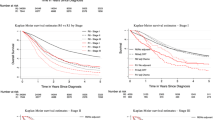Abstract
The R1 rate and prognostic significance of microscopic margin involvement differ consistently between published series. This divergence results from a lack of consensus regarding various aspects of margin status assessment. Central to the controversies is the lack of clarity about what ‘R1’ exactly stands for. The current UICC definition—residual microscopic tumor—is possibly too general and invites divergent interpretations. Adherence to different diagnostic criteria for microscopic margin involvement and divergent terminology for the various margins of pancreatoduodenectomy specimens add to the confusion. Furthermore, recent studies demonstrated that the dissection technique and extent of tissue sampling influence the accuracy of margin assessment. Axial specimen slicing, extensive tissue sampling, and multicolored margin inking result in a significantly higher, more accurate R1 rate than when using traditional grossing techniques. Only when international consensus on these various aspects is reached will pathology data on margin involvement be reliable and can multicenter clinical trials produce compelling evidence that allows improved pancreatic cancer treatment.
Zusammenfassung
Die R1-Rate und die prognostische Bedeutung der mikroskopischen Resektionsrandbeteiligung unterscheiden sich beständig zwischen veröffentlichten Fallserien. Dieser Unterschied resultiert aus einem fehlenden Konsens hinsichtlich verschiedener Aspekte der Beurteilung des Resektionsrandstatus. Zentral für die Meinungsverschiedenheiten ist die fehlende Klarheit darüber, wofür „R1“ genau steht. Die aktuelle UICC-Definition – mikroskopischer Residualtumor – ist möglicherweise zu allgemein und lädt zu verschiedenen Interpretationen ein. Die Beachtung verschiedener diagnostischer Kriterien für die mikroskopische Resektionsrandbeteiligung und unterschiedliche Terminologien für die verschiedenen Ränder der Pankreatikoduodenektomiepräparate tragen zu der Verwirrung bei. Darüber hinaus zeigten aktuelle Studien, dass die chirurgische Präparationstechnik und das Ausmaß der Gewebeprobenentnahme die Genauigkeit der Resektionsrandbeurteilung beeinflussen. Axiales Schneiden der Präparate, ausgedehnte Gewebeprobenentnahme und mehrfarbige Randfärbung führen zu einer signifikant höheren, genaueren R1-Rate als die Verwendung herkömmlicher Dissektionstechniken. Nur dann, wenn ein internationaler Konsens hinsichtlich der verschiedenen Aspekte erzielt wird, können pathologische Daten zur Resektionsrandbeteiligung reliabel werden und klinische Multizenterstudien zu überzeugender Evidenz gelangen, die eine bessere Behandlung bei Pankreaskarzinomen ermöglicht.





Similar content being viewed by others
References
Verbeke CS, Leitch D, Menon KV et al (2006) Redefining the R1 resection in pancreatic cancer. Br J Surg 93:1232–1237
Esposito I, Kleeff J, Bergmann F et al (2008) Most pancreatic cancer resections are R1 resections. Ann Surg Oncol 15:1651–1660
Menon KV, Gomez D, Smith AM et al (2009) Impact of margin status on survival following pancreatoduodenectomy for cancer: the Leeds Pathology Protocol (LEEPP). HPB (Oxford) 11:18–24
Campbell F, Smith RA, Whelan P et al (2009) Classification of R1 resections for pancreatic cancer: the prognostic relevance of tumour involvement within 1 mm of a resection margin. Histopathology 55:277–283
Jamieson NB, Foulis AK, Oien KA et al (2010) Positive immobilization margins alone do not influence survival following pancreatico-duodenectomy for pancreatic ductal adenocarcinoma. Ann Surg 251:1003–1010
Willett CG, Lewandrowski K, Warschaw AL et al (1993) Resection margins in carcinoma of the head of the pancreas: implications for radiation therapy. Ann Surg 217:144–148
Millikan KW, Deziel DJ, Silverstein JC et al (1999) Prognostic factors associated with resectable adenocarcinoma of the head of the pancreas. Am Surg 65:618–623
Benassai G, Mastrorilli M, Quarto G et al (2000) Factors influencing survival after resection for ductal adenocarcinoma of the head of the pancreas. J Surg Oncol 73:212–218
Sohn TA, Yeo CJ, Cameron JL et al (2000) Resected adenocarcinoma of the pancreas—616 patients: results, outcomes, and prognostic indicators. J Gastrointest Surg 4:567–579
Neoptolemos JP, Stocken DD, Dunn JA et al (2001) Influence of resection margins on survival for patients with pancreatic cancer treated by adjuvant chemoradiation and/or chemotherapy in the ESPAC-1 randomized controlled trial. Ann Surg 234:758–768
Raut CP, Tseng JF, Sun CC et al (2007) Impact of resection status on pattern of failure and survival after pancreaticoduodenectomy for pancreatic adenocarcinoma. Ann Surg 246:52–60
Westgaard A, Tafjord S, Farstad IN et al (2008) Resectable adenocarcinomas in the pancreatic head: the retroperitoneal resection margin is an independent prognostic factor. BMC Cancer 8:5–15
Hsu CC, Herman JM, Corsini MM et al (2010) Adjuvant chemoradiation for pancreatic adenocarcinoma: the Johns Hopkins Hospital-Mayo Clinic collaborative study. Ann Surg Oncol 17:981–990
Gnerlich JL, Luka SR, Deshpande AD et al (2012) Microscopic margins and patterns of treatment failure in resected pancreatic adenocarcinoma. Arch Surg 147:753–760
Verbeke CS, Knapp J, Gladhaug IP (2011) Tumour growth is more dispersed in pancreatic head cancers than in rectal cancer—implications for resection margin assessment. Histopathology 59:1111–1121
Chang DK, Johns AL, Merrett ND et al (2009) Margin clearance and outcome in resected pancreatic cancer. J Clin Oncol 27:2855–2862
Verbeke CS, Gladhaug IP (2012) Resection margin involvement and tumour origin in pancreatic head cancer. Br J Surg 99:1036–1049
Griffin JF, Smalley SR, Jewell W et al (1990) Patterns of failure after curative resection of pancreatic carcinoma. Cancer 66:56–61
Verbeke CS (2013) Resection margins in pancreatic cancer. Surg Clin N Am 93:647–662
Compliance with ethical guidelines
Conflict of interest. C.S. Verbeke states that there are no conflicts of interest. The supplement this article is part of is not sponsored by the industry.
The accompanying manuscript does not include studies on humans or animals.
Author information
Authors and Affiliations
Corresponding author
Rights and permissions
About this article
Cite this article
Verbeke, C. Resection margins in pancreatic cancer. Pathologe 34 (Suppl 2), 241–247 (2013). https://doi.org/10.1007/s00292-013-1799-5
Published:
Issue Date:
DOI: https://doi.org/10.1007/s00292-013-1799-5




